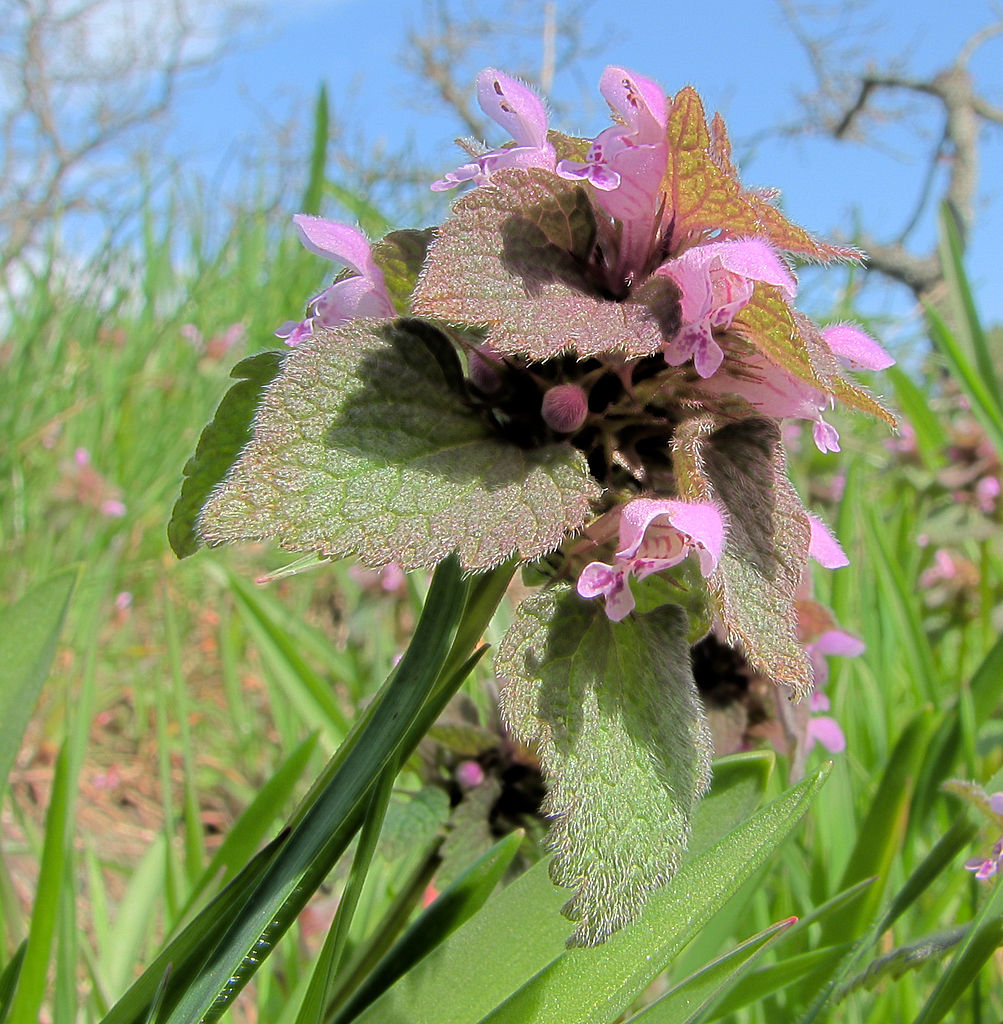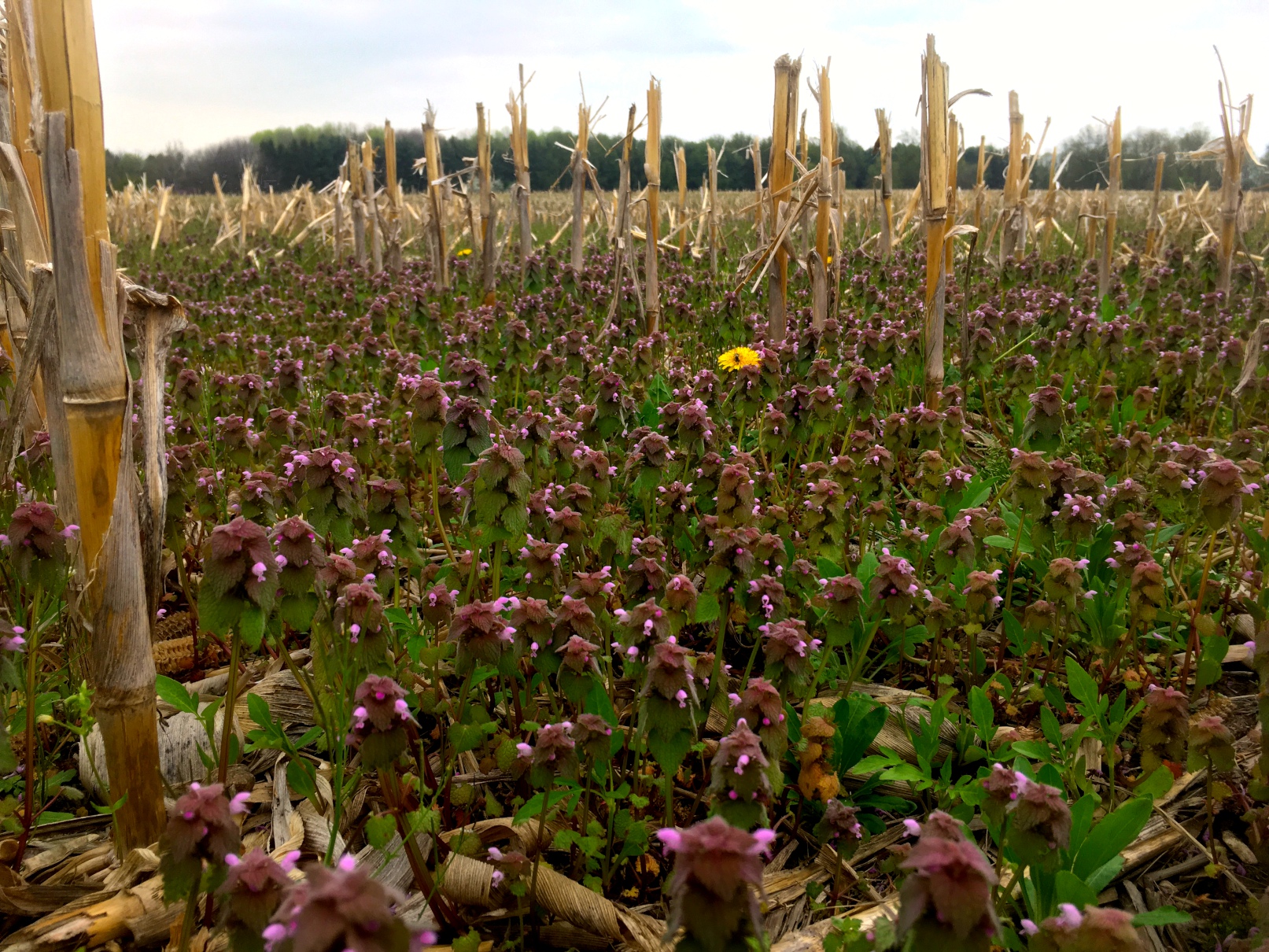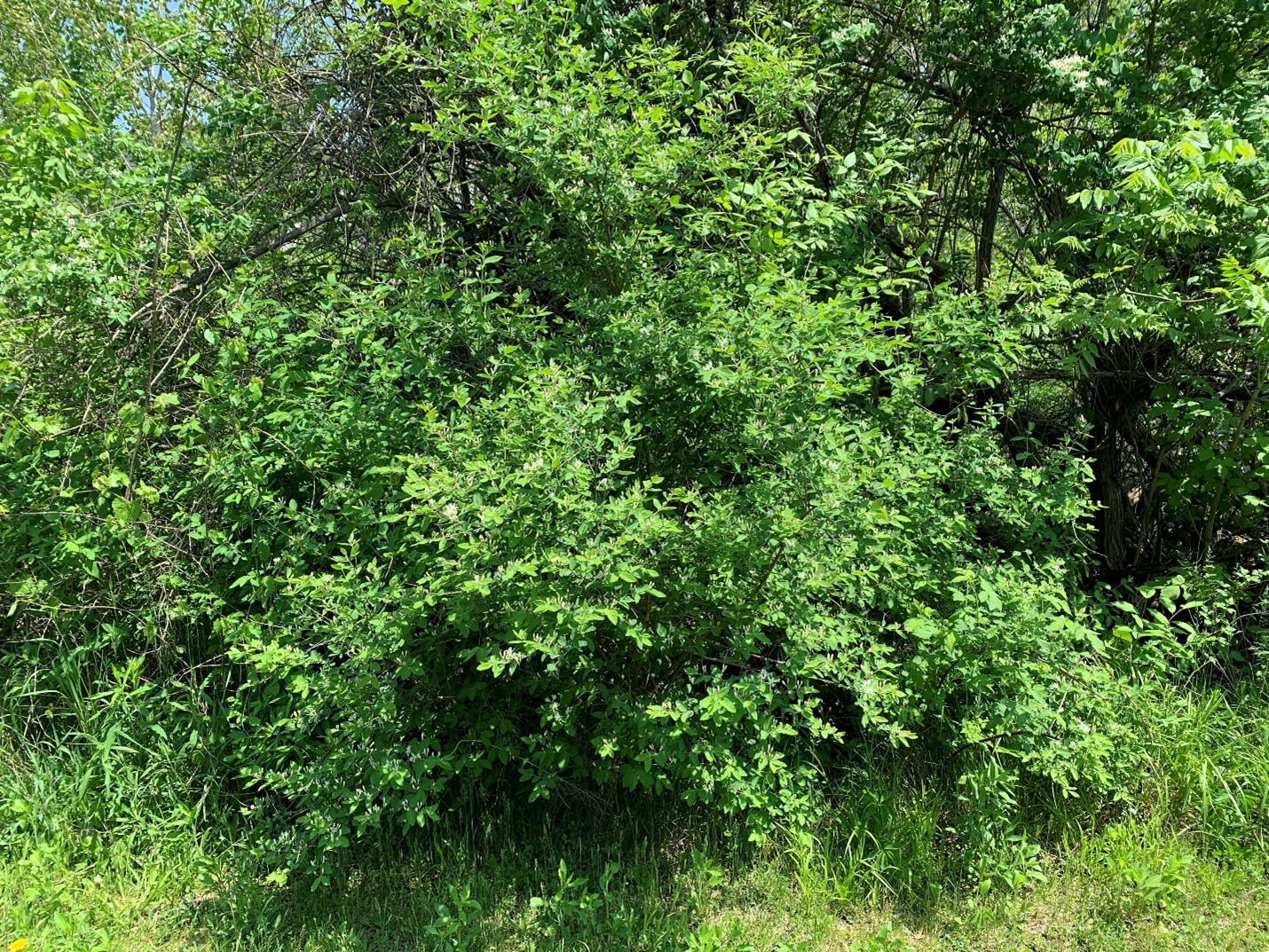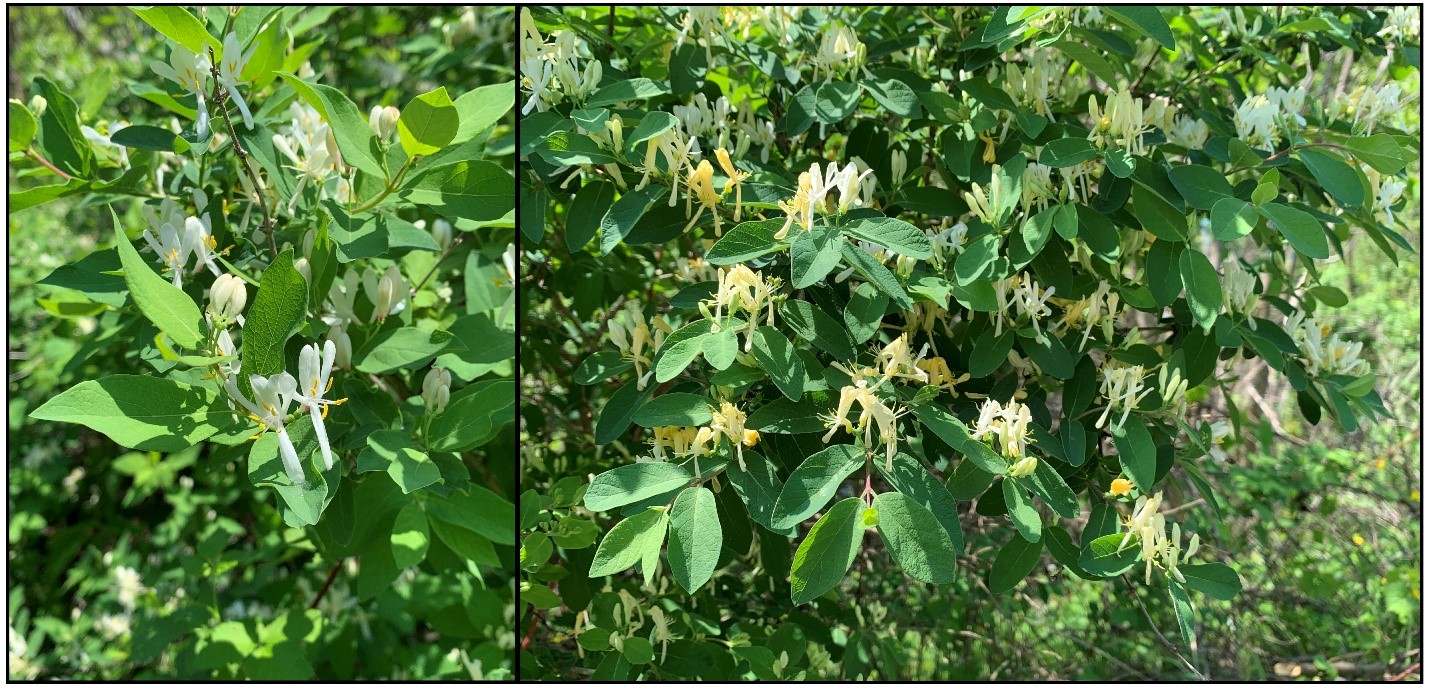Drive-by botany: Purple dead-nettle and Morrow’s honeysuckle
Profiles of common Michigan roadside flora in mid-May 2022.

Authors’ note: Drive-by Botany is a continuing series that highlights flowering plants commonly seen from the road. As a service to new readers, we include the introduction with each article. If you're already familiar with the premise, feel free to skip down to the good stuff.
Has a patch of flowers ever caught your eye as you travelled down the road? It certainly happens to us all the time! As gardeners and naturalists, we're always interested increasing functional diversity in our gardens and landscapes, so we thought it would be fun to consider some of the roadside plants that we see every day. Each article in this series will feature two plant species that are currently blooming and frequently observed from the road. Our goal is to answer two simple questions:
- What are they?
- Would they make good garden plants?
As part of the process, we'll include some biological tidbits and a few useful characteristics for identification. Please note that some of the plants we feature are exotic invasive species; we'll be sure to include recommendations from land management professionals on how to manage them in your landscape.
May 2022 - week 21, growing degree days (GDD) 1,045 (base 32 F), East Lansing, Michigan
Purple dead-nettle (Lamium purpureum)
Synonyms: red dead-nettle
Purple dead-nettle is a member of the mint family (Lamiaceae), a large and familiar group of plants known for producing aromatic oils. Many people will probably recognize other mints, such as spearmint and lemon balm, as well as less obvious examples like motherwort and catmint (Nepeta spp.). The stereotypical mint species has a square stem, opposite leaves, and flowers that grow in tight clusters near the top of the stem. Although the square stems serve as an identifying characteristic, it should be noted that this trait can be found in other families. Of those three, the only trait that is shared across all mint species are opposite leaves, so care should be taken during the identification process.
Lamium purpureum is a winter annual that germinates in the fall or winter and grows very slowly until the weather warms up in the spring. This is an ephemeral species with leaves and blossoms that senesce quickly, leaving behind the fruiting stalks that reseed the ground with next year's population.
Description
Flowers: Purple dead-nettle has small light purple flowers that are arranged in a cluster and emerge in a ring-like pattern around the top end of the stem. Like other species in the genus Lamium, the flowers are sessile (attached to the stem without a stalk) with petals that are fused to form a tube with an upper lip and a lower lip. The upper lip is shaped like a hood that hangs over the opening of the tube, while the lower lip splits into two large lobes with dark purple splotches and wavy margins (Photo 2).

Leaves: The leaves of L. purpureum tend to be heart shaped (cordate) with rounded teeth along the margins (crenate) and measure anywhere from 0.75 to 1.5 inches across Unlike the closely related henbit (Lamium amplexicaule), purple dead-nettle leaves are bunched up near the top of the plant and connected to the stem by a short petiole. Leaf color transitions from green near the bottom of the plant to purple near the top (Photos 1 and 2).
Seeds/Fruit: L. purpureum produces tiny brown seeds with small white spots, measuring approximately 8 hundredths of an inch in length. Although information on purple dead-nettle seeds is difficult to find, it has been noted that a single henbit plant (a close relative) will produce 200 seeds.
Height: Usually 2-8 inches. Occasionally up to 12 inches tall.
Distribution: L. purpureum has been documented in 32 Michigan counties, mostly in the southern half of the lower peninsula. This is likely an underestimation of its distribution because it thrives in a variety of habitats including gardens, lawns, trail sides, roadsides, and railroads. Farm fields are particularly noteworthy habitats. In the spring, one can watch large sections of unplowed fields turn purple as the dead-nettle comes into full bloom (Photo 3). It also seems to do quite well in ecological transition areas such as the borders of woods and river banks.

Blooming period: Purple dead-nettle blooms in mid-spring. Depending on the weather, it can be anywhere from early to mid-April through late May.
Native status: Exotic/Introduced. This species is not native to the United States. It was first collected in Michigan in 1920 and has since become naturalized.
Garden uses: This species is often considered a weed of gardens and lawns. Much like the dandelion, however, purple dead-nettle provides an early season source of pollen and nectar for bees and other pollinators. Large swaths of dead-nettle in full bloom are quite lovely, transforming ordinary patches of ground into beautiful shades of purple (Photo 3). Although the aesthetic effect can be quite striking, it is short-lived and quickly replaced with the somewhat unsightly yellowing stalks of senescent plants. In his own (somewhat wild) garden, the author allows them to bloom and removes them when they start to fade in the heat of the oncoming summer weather.
Common look-alikes: Henbit (Lamium amplexicaule)
Morrow’s Honeysuckle (Lonicera morrowii)
Morrow’s honeysuckle is one of the first shrubs to leaf out in the spring, along with some of the other honeysuckle species, and an early bloomer. These multi-stemmed shrubs usually form thickets along roadsides and at disturbed sites. Morrow’s honeysuckle is an invasive species here in Michigan that displaces native shrubs. These shrubs can grow up to 6 feet.

Description
Flowers: White, usually turning yellow with age and fragrant. The flowers are tubular and often form in pairs along the stem.
Leaves: Elliptical with smooth edges. A key characteristic of honeysuckles is having opposite leaf arrangement or having leaves directly across from each other. Morrow’s honeysuckle leaves are grey-green and slightly hairy underneath.
Stems: Young stems are slightly hairy. Older branches are hollow with gray-tan shaggy bark. There are often many, arching branches that make up the shrub canopy.
Seeds/Fruit: Bright red fruits borne in pairs that mature around July. Birds and other animals feed on these fruits and spread the species.

Distribution: Found throughout Michigan. It has been recorded in 34 Michigan counties from the lower southern peninsula to the upper peninsula.
Blooming period: May through June.
Native status: Exotic/Introduced. This species is not native to the United States. As with other non-native shrub honeysuckle species (Lonicera tatarica, L. xylosteum, L. x bella, L. maackii), Morrow’s honeysuckle is considered ecologically invasive and is the target of control efforts to protect and restore native biodiversity.
Garden uses: Morrow’s honeysuckle should not be planted in the garden due to its invasive tendencies. Bush honeysuckle (Diervilla lonicera) is a native species that makes for a good alternative, and it can be found in the nursery trade. The MSU Extension article “Native plants for Michigan landscapes: Part 2 – Shrubs” has additional alternatives.
Young Morrow’s honeysuckle plants can be removed via hand digging. For larger shrubs, the “cut and dab” method using targeted herbicides can be effective as well as basal bark treatment.
Common look-alikes: Amur Honeysuckle (Lonicera maackii) looks very similar, but leaves are a darker green and have a more distinctly pointed tip. Tartarian Honeysuckle (Lonicera tatarica) has pink flowers. Hybrid honeysuckle, also called Bell’s honeysuckle, (Lonicera x bella) is a cross between Tartarian and Morrow’s honeysuckle and has pink flowers. All of these species have similar invasive tendencies and growth habits (and hollow, older stems). Canadian fly honeysuckle, also called American fly honeysuckle, and Swamp fly honeysuckle (Lonicera oblongifolia) are two somewhat similar looking native species.
Want more Drive-by Botany?
Check out some of our roadside adventures from last spring!
Questions? Feel free to contact Jeremy Jubenville or Isabel Branstrom with the MSU Extension landscape team.
Resources
- Michigan Flora (2001) – E. Voss
- USDA NRCS Plant Materials Program
- Edible Wild Plants (2009) – Elias & Dykeman



 Print
Print Email
Email





